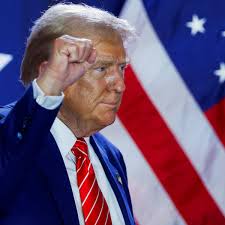
As President-elect Donald Trump prepares to assume office, he inherits an economy exhibiting robust health: output is expanding above trend, the labor market is near maximum employment, and inflationary pressures persist. This economic vigor presents a complex backdrop for implementing his proposed policies, which include aggressive import tariffs, strict immigration controls, deregulation, and a reduction in government size. The central question arises: How will these initiatives impact an economy that, by several indicators, may not require significant intervention?
Economic Landscape at Inception
In 2017, during Trump's initial term, the U.S. economy was recovering from the 2007-2009 financial crisis, characterized by sluggish growth and incomplete employment recovery. The Tax Cuts and Jobs Act provided a stimulus that many deemed necessary at the time. However, the current economic environment differs markedly. The unemployment rate stands at a low 4.1%, with December alone adding 256,000 jobs, indicating a labor market operating near full capacity. Inflation remains above the Federal Reserve's 2% target, suggesting limited room for additional stimulus without overheating the economy.
Potential Impacts of Proposed Policies
Trump's policy agenda includes imposing import tariffs, enforcing strict immigration controls, and implementing deficit-funded tax cuts. Economists caution that such measures could disrupt the current economic equilibrium. Mark Zandi, chief economist at Moody's Analytics, warns that these policies "will do harm" to the economy, with the extent depending on their implementation aggressiveness. Similarly, Harvard economist Karen Dynan notes that constraints like persistent inflation and higher federal deficits necessitate a cautious approach to policy changes.
Market Sentiments and Fiscal Concerns
Financial markets reflect apprehension regarding potential policy shifts. Rising bond yields and a recent stock selloff following strong employment data suggest investor concerns about fiscal discipline and the possibility of an overheating economy. The Federal Reserve has expressed vigilance, with Governor Christopher Waller highlighting concerns about fiscal deficits and their influence on long-term bond yields. The central bank's focus remains on controlling inflation while maintaining economic stability.
Global Economic Context
The global economic landscape adds another layer of complexity. The United Nations projects global growth to remain at 2.8% in 2025, unchanged from 2024, indicating a subdued international environment. Trade tensions and geopolitical uncertainties further complicate the scenario, necessitating careful navigation of international relations and trade policies.
Strategic Considerations for the Incoming Administration
Given the current economic strength, the incoming administration faces the challenge of implementing policies that do not disrupt positive momentum. Experts suggest that a prudent approach would involve:
As President-elect Trump prepares to take office, the robust state of the U.S. economy presents both opportunities and challenges. Implementing aggressive policy changes in such an environment requires a nuanced approach to avoid unintended disruptions. By adopting measured strategies that consider current economic strengths and potential vulnerabilities, the new administration can aim to sustain growth, maintain stability, and address long-term challenges without undermining the progress achieved in recent years.
(Source:www.telegrafi.com)
Economic Landscape at Inception
In 2017, during Trump's initial term, the U.S. economy was recovering from the 2007-2009 financial crisis, characterized by sluggish growth and incomplete employment recovery. The Tax Cuts and Jobs Act provided a stimulus that many deemed necessary at the time. However, the current economic environment differs markedly. The unemployment rate stands at a low 4.1%, with December alone adding 256,000 jobs, indicating a labor market operating near full capacity. Inflation remains above the Federal Reserve's 2% target, suggesting limited room for additional stimulus without overheating the economy.
Potential Impacts of Proposed Policies
Trump's policy agenda includes imposing import tariffs, enforcing strict immigration controls, and implementing deficit-funded tax cuts. Economists caution that such measures could disrupt the current economic equilibrium. Mark Zandi, chief economist at Moody's Analytics, warns that these policies "will do harm" to the economy, with the extent depending on their implementation aggressiveness. Similarly, Harvard economist Karen Dynan notes that constraints like persistent inflation and higher federal deficits necessitate a cautious approach to policy changes.
Market Sentiments and Fiscal Concerns
Financial markets reflect apprehension regarding potential policy shifts. Rising bond yields and a recent stock selloff following strong employment data suggest investor concerns about fiscal discipline and the possibility of an overheating economy. The Federal Reserve has expressed vigilance, with Governor Christopher Waller highlighting concerns about fiscal deficits and their influence on long-term bond yields. The central bank's focus remains on controlling inflation while maintaining economic stability.
Global Economic Context
The global economic landscape adds another layer of complexity. The United Nations projects global growth to remain at 2.8% in 2025, unchanged from 2024, indicating a subdued international environment. Trade tensions and geopolitical uncertainties further complicate the scenario, necessitating careful navigation of international relations and trade policies.
Strategic Considerations for the Incoming Administration
Given the current economic strength, the incoming administration faces the challenge of implementing policies that do not disrupt positive momentum. Experts suggest that a prudent approach would involve:
- Avoiding Aggressive Trade Policies: Imposing steep import tariffs could incite trade wars, leading to increased costs for consumers and businesses, potentially stoking inflation and dampening economic growth.
- Moderating Immigration Controls: Strict immigration policies could reduce labor force growth, adversely affecting industries reliant on immigrant labor and potentially slowing economic expansion.
- Ensuring Fiscal Responsibility: Deficit-funded tax cuts may exacerbate federal deficits and elevate borrowing costs. A focus on fiscal discipline could help maintain investor confidence and economic stability.
- Coordinating with the Federal Reserve: Aligning fiscal policies with the Federal Reserve's monetary stance is crucial to manage inflationary pressures and sustain economic growth.
As President-elect Trump prepares to take office, the robust state of the U.S. economy presents both opportunities and challenges. Implementing aggressive policy changes in such an environment requires a nuanced approach to avoid unintended disruptions. By adopting measured strategies that consider current economic strengths and potential vulnerabilities, the new administration can aim to sustain growth, maintain stability, and address long-term challenges without undermining the progress achieved in recent years.
(Source:www.telegrafi.com)





